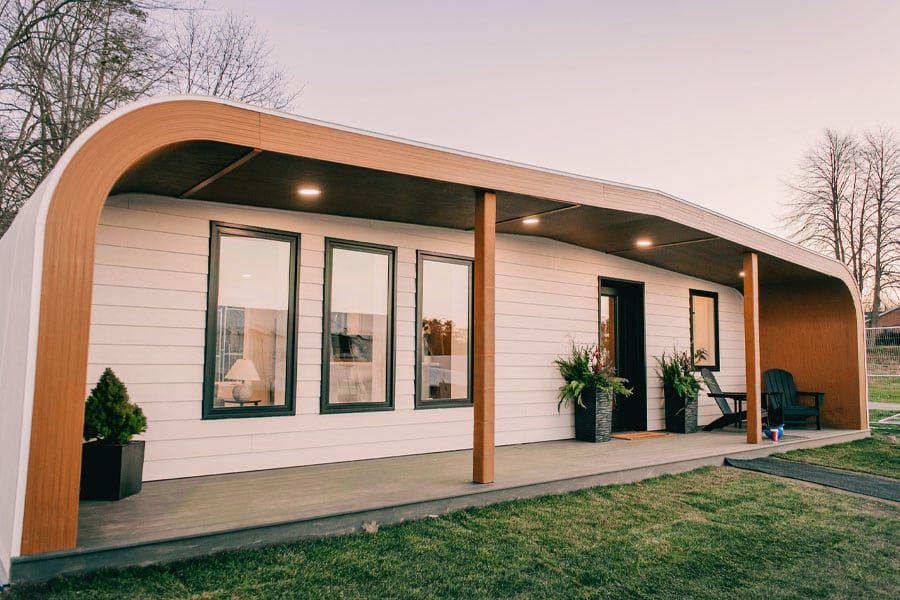In November 2022, the Advanced Structures and Composites Center (ASCC) at the University of Maine unveiled BioHome3D, a 600-square-foot prototype composed entirely of printed wood fibers and bioresins. The house is fully recyclable and 100% insulated with wood. Due to the precise printing process, construction nearly eliminated waste. And most importantly, BioHome3D offers the potential to solve the affordable housing shortage.
Along with the rest of the country, Maine is experiencing a crisis-level affordable housing shortage. Nationally there are only 36 affordable and available rental homes for every 100 extremely low-income households. Maine needs 20,000 more affordable housing units, according to Mainebiz, and the country as a whole requires 7 million more, reports the National Low Income Housing Coalition.
Issues facing the construction industry—including a labor shortage and material price increases—drive up construction costs and limit the affordable housing supply. BioHome3D is a creative solution that can strengthen the forest products industry and provide secure homes for low-income Mainers, helping to reduce childhood poverty and increase economic mobility.
Solving supply chain issues with local sourcing
BioHome3D’s printing technology relies on local products to help address global supply chain constraints.
“The closure of many Maine paper mills has led to a surplus of wood residuals,” said Evan Gilman, chief engineer, additive manufacturing at ASCC. “This 3D technology uses wood residuals from the mills and generates demand for low-value wood products harvested from sustainably managed forests.”
ASCC selected the bio-based materials for additive manufacturing—also known as 3D printing—after extensive research. The wood fibers and bioresins used for feedstock offer the additional advantage of higher compressive strength than the concrete typically used. And unlike concrete-based technologies, which produce printed walls set atop a traditional cast concrete foundation, BioHome3D’s floors, walls and roof are all printed.
That makes BioHome3D particularly eco-friendly. Buildings currently account for nearly 40% of global carbon emissions, according to the United Nations Environment Programme. “Sustainably grown wood fiber is a renewable resource that captures carbon during the tree growth cycle,” Gilman said. “BioHome3D may be thought of as a carbon storage and sequestration unit during its lifetime and after it is recycled.”
Generations to come can fully recycle BioHome3D as it reaches end of life. In fact, ASCC is conducting testing to see how the materials perform when recycled and reused five times.
Cutting construction time, need for skilled labor
The successful print of BioHome3D builds on the ASCC’s work in advanced manufacturing, design and modeling. The world’s largest polymer 3D printer handled the majority of BioHome3D construction, reducing the demand for the skilled labor conventional methods require. ASCC printed the prototype in four self-supporting modules that allow flexibility for the foundation.
BioHome3D needs far less time on-site for construction. Automated, off-site manufacturing enables assembly in just half a day after moving the modules to the site. A single electrician had electricity running within two hours.
As ASCC and partners scale up manufacturing technology and materials production, homebuyers can expect faster delivery schedules. “UMaine’s planned GEM Factory of the Future expansion will allow the ASCC to scale its printing capabilities, with a future goal of printing one home every 48 hours,” Gilman said.
“This project gives us a real possibility to achieve something that has eluded us to date—the idea that we can create housing units in a fraction of the time with a fraction of the workforce,” said Daniel Brennan, director of MaineHousing.
Building a neighborhood of 3D homes
The BioHome3D prototype currently sits on a foundation outside ASCC. Data from sensors for thermal, environmental and structural monitoring show BioHome3D has performed well in Maine’s winter conditions, Gilman reported. Researchers plan to use the data collected to determine specific performance measures and improve future designs.
The advanced manufacturing processes and materials developed allow customizing of future affordable houses to meet homeowner preferences for space, energy efficiency and aesthetics. Scaling the thickness of the walls and roof makes tailoring R-values possible, too.
UMaine is partnering with a local nonprofit and MaineHousing to build a neighborhood in the greater Bangor area with nine 3D-printed homes for people experiencing homelessness. The project recently received $3.3 million in funding. Gilman said BioHome3D is several years away from commercialization. But when the time comes, the printed structures may offer a viable option for the 60% of low-income renters in Maine who now spend more than half of their income on housing.












